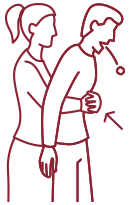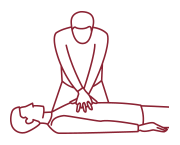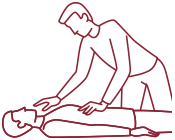Did you know choking is a leading cause of death in children? Recent studies report that every five days, at least one child dies from choking. While the most common cause of choking is food, small toys, coins, and other household items are also potential dangers. It’s recommended to keep a close eye on children when they eat to prevent choking.
Choking doesn’t just affect children either; it is also a prominent cause of death in seniors 65 years of age and older. As we age, we can develop disorders like dysphagia (difficulty swallowing), which can increase the risk of choking.
Why all the talk about choking? We’re glad you asked. No, we aren’t just trying to scare you. June 1st is National Heimlich Maneuver Day. A day devoted to spreading awareness about the dangers of choking and information on the life-saving technique. In recognition of this day, and in our effort to continue to be your Best Neighbors Ever, we’ve put together a quick guide for you. No need to Google the maneuver; we got Dr. Dad to break it down for you right here, as well as some other helpful first aid tips!

What exactly is choking?
Choking happens when food or other small objects get caught in the throat and block the airway. When the airway is blocked, oxygen can’t get from your lungs to your brain. Going more than 4 minutes without oxygen can cause severe brain damage or even death. The main symptom of choking is not being able to breathe or speak. Other symptoms might include coughing and, in extreme cases, turning blue.
How do you perform the Heimlich?
The Heimlich Maneuver was created in 1972 by a thoracic surgeon, Henry Heimlich, and is the best way to aid someone who is choking. That being said, not all Heimlich maneuvers are created equal. Depending on the person choking’s size, age, or conscious state, the maneuver might have to be adjusted. Below, we’ve provided steps for performing the maneuver in several different scenarios.
To perform the Heimlich maneuver on an adult:

- Stand behind the person in distress.
- Form a fist with one hand, facing it thumbs side in just below the person’s rib cage in the front.
- With your other hand, grab your fist.
- Give four quick inward and upward thrusts. Remember to keep your arms off the other person’s rib cage.
- Repeat this until the obstructing object is coughed out.
To perform the Heimlich maneuver on an unconscious person:

- If the person is lying down or unconscious, straddle them, placing the heel of your hand just above the waistline.
- Place your other hand on top of this hand.
- Give four quick thrusts, remembering to keep your elbows straight.
- Repeat this procedure several times until the obstructing object is coughed out.
To perform the Heimlich maneuver on a child:
- Stand behind the child.
- Wrap your arms around their waist, form a fist with one hand, and place it, thumb side in, between the ribs and waistline.
- With the other hand, grab your fist.
- Keeping your arms off the child’s rib cage, give four quick inward and upward thrusts.
- Repeat this several times until the obstructing object is coughed out.
Heimlich maneuver on an infant:

- Resting your forearm on your leg, place the infant face down across your forearm, and support the infant’s head with your hand.
- With the heel of your other hand, give four forceful blows to the infant’s back.
- You may have to repeat this several times until the obstructing object is coughed out.
This maneuver might not always work on an infant. If the above strategy isn’t dislodging the obstruction, do the following:
- With two fingers one finger width below an imaginary line connecting the nipples, give four forceful thrusts to the chest to a depth of 1 inch.
- You may have to repeat this several times until the obstructing object is coughed out.
Other types of first aid.
Witnessing someone choking is just one of the many emergencies we may experience. Luckily, performing the Heimlich maneuver is a reasonably simple procedure, but some situations might call for someone more experienced in first aid.

CPR, or Cardiopulmonary resuscitation, is an emergency procedure combining artificial ventilation (breathing air into someone’s lungs) and chest compressions. The goal of CPR is to preserve intact brain function manually until blood circulation and breathing are restored.
While you don’t have to be certified to perform CPR in an emergency, we do not encourage anyone to perform CPR who has not taken a class. Even after being trained, CPR can be a complicated procedure and can result in fractures to the ribs and sternum. If you think someone requires CPR, call 911 immediately and search for a qualified bystander to help. If there is no one around and you feel like you must perform CPR to save the person’s life.
Remember the seven fundamental principles of CPR:
- Call 911 or ask someone else to do so.
- Lay the person on their back and open their airway.
- To begin chest compressions, the palm needs to be placed in the lower 1/3rd of the sternum.
- Use your body weight to help administer compressions that are at least 2 in. deep but not more than 2.4 in. and delivered at a rate of at least 100-120 compressions per minute. A good rule of thumb is to administer the compressions to the beat of ‘Staying Alive’ to keep track.
- Minimize interruptions in compressions.
- If tired, find someone else to take over after 2 minutes of compressions.
- Use an AED as soon as it is available.
Get certified
If you’ve never done it before, we encourage all of you to find a class and get certified. Being certified in CPR and other first-aid procedures like the Heimlich aren’t just handy skills to have. In addition to saving someone’s life, it can also make you an asset in your current or future jobs. Community centers or recreation centers in your area likely have information on classes, but you can always do your own research. Check out the Houston Red Cross to find first aid classes near you. Neighbors locations also offer free first aid classes periodically. You can like and follow Neighbors on all our social channels for updates on upcoming CPR classes.
